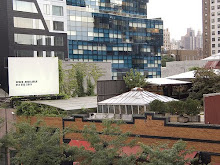

 51-53 Christopher Street
51-53 Christopher Street
In the United States, the 1960’s were a time of political unrest and radical leftist movements, including the Black Power and anti-war movements. Young people across the nation were coming together and demanding political reform through increasingly radical forms of activism and demonstration. While other groups were militarizing, the visible gay and lesbian groups at the time, sects of what is now referred to as the homophile movement[1], were insistent upon making change through the courts and no where else; the homophile movement remained passive and almost completely invisible.
At this time 51-53 Christopher Street was the location of the Stonewall Inn, a popular hangout for young, mostly non-white gay men, drag queens, and transvestites[2] in the West Village. In the early morning of June 28th, 1969, the bar was the target of a police raid, a common occurrence for gay bars at the time; however, the raid did not proceed as planned. One patron resisted arrest, fought back against the officer attempting to arrest her, and suddenly, the scene became a collective gay uprising, lasting for two days, calling for “Gay Power”.[3] In a matter of months the homophile movement had been transformed into the Gay Liberation movement, and spread across the nation.
This outburst of collective action seemed sudden—there had been no previous push for radical collective action among gay communities—but it was actually born from a specific political context. The Gay Liberation movement in part owes its existence to the radical leftist movements that preceded it, most particularly the Black Power movement, which “came to embody a distinctive form of politics and culture…liberation replaced equality, and self-determination superseded integration,”.[4] Also, the Gay Liberation movement spread with unmatched speed because it used the infrastructures of other radical groups as means for visibility and recruitment. Although the homophile movement refused to take the form of a liberation movement, gay individuals across the country were nevertheless influenced by the radical politics gripping the nation’s youth. As police raids on gay bars were increasing in frequency and violence, the gay community joined together and fought back on Christopher Street.
The original Stonewall Inn closed at the end of 1969, and today the location is a National Historic Landmark, however, the neighborhood around it has changed significantly over the years. As the neighborhood has changed, the result of gentrification, so has the gay movement and gay politics. It started when gay men of color fought back against police violence, which blew up into a grassroots movement for freedom, in the face of a hostile polity.[5] As the movement gained visibility, it also gained more political acceptance until by the 1990’s the gay movement had reverted back to a movement working within the political structure, rather than a movement demanding freedom from the political structure. The gay movement welcomed access to the polity, even if it meant gaining that access by virtue of race, gender, or socio-economic status.[6] By ideologically accepting such access based on certain identities, the gay movement became closed to everyone else, whether or not they were stigmatized by heteronormativity. The gay movement became a white, middle-class movement by accepting the privileges of such an identity.
- Olga Diaz and Elizabeth Perry
[1] Nicholas C. Edsall, Toward Stonewall: Homosexuality and Society in the Modern Western World, University of Virginia Press, 2003.
[2] John D’Emilio, “A New Beginning: The Birth of Gay Liberation,” Sexual Politics, Sexual Communities: The Making of a Homosexual Minority in the United States, 1940-1970 (University of Chicago Press, 1998): 223-239.
[3] John D’Emilio, “A New Beginning: The Birth of Gay Liberation,” Sexual Politics, Sexual Communities: The Making of a Homosexual Minority in the United States, 1940-1970 (University of Chicago Press, 1998): 223-239.
[4] John D’Emilio, “A New Beginning: The Birth of Gay Liberation,” Sexual Politics, Sexual Communities: The Making of a Homosexual Minority in the United States, 1940-1970 (University of Chicago Press, 1998): 223-239.
[5] Mary Bernstein, “Celebration and Suppression: The Strategic Uses of Identity by the Lesbian and Gay Movement,” American Journal of Sociology (University of Chicago Press, 1997): 531-565.
[6] Mary Bernstein, “Celebration and Suppression: The Strategic Uses of Identity by the Lesbian and Gay Movement,” American Journal of Sociology (University of Chicago Press, 1997): 531-565.

No comments:
Post a Comment